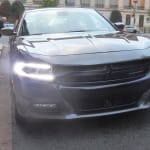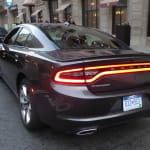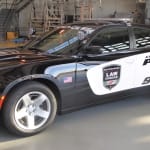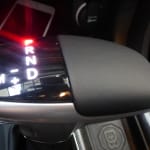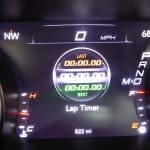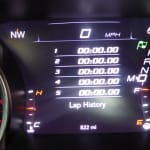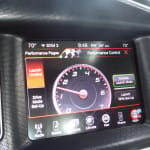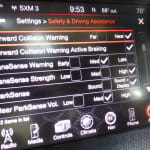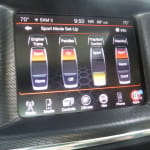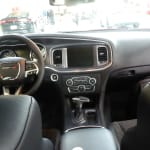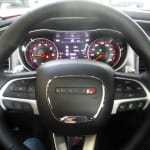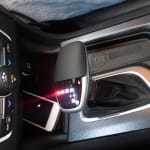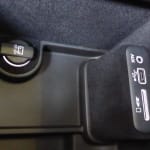2015 Dodge Charger: Family Car Built for the Race Track
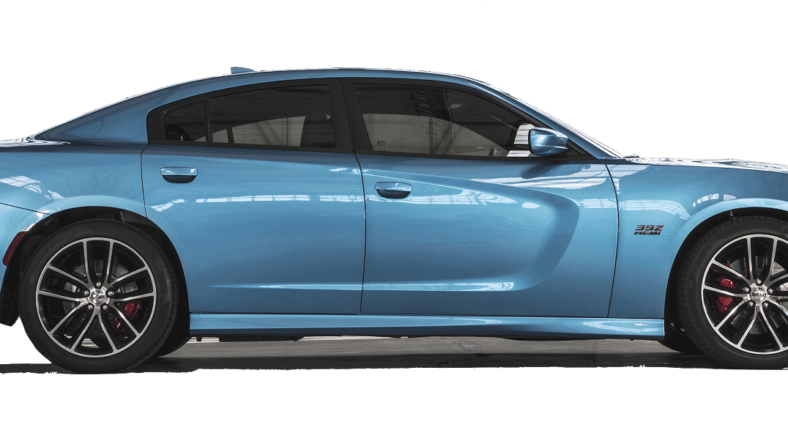
Yes, you read that right: A family muscle car, built for speed.
So, first a little backstory on the 2015 Dodge Charger. Dodge has a heritage of building cars designed to thrill. The Dodge Brothers founded the company to innovate engine design, and by the 1950s the brand was a staple on the NASCAR circuit.
Dodge Chargers starred in famous high-speed classics such as The Dukes of Hazard (remember the General Lee?) and the Fast And Furious movies (in which star Vin Diesel drove a Charger). And when you get to drive that fast, well, wow.
Dodge Charger stays in balance: a family car with muscle car DNA
But looking at any of the models in the Charger line, unless you notice the iconic screaming cat icon on the side of the Hellcat, the models are excitingly similar and democratic.
The exterior lines of the Charger have been smoothed to a muscly tone and are framed by iconic tail lights and a front grille that personifies it with a confident snarl.
- Grrr: LED running lights frame the headlights, giving the Charger an aggressive glow
- The Charger has been redesigned from top to bottom for a sleeker, more muscly look
- Me with the Charger Hellcat after a trip around the race track. Can you see I’m STILL shaking?
- The Charger’s ‘racetrack’ tail lights circle the rear of the car
- Chargers lined up and ready to go
- The Charger comes in a specially outfitted model designed to protect and to serve
Have a need for speed? Take it to the track
Of course, Fast and Furious is great on the big screen, but even if traffic congestion isn’t a barrier, a glance in the rear view mirror at the smiling little faces beaming back at you can be a mood killer. It just isn’t worth it.
Luckily, there’s the track. More and more, it’s where drivers can go for expert guidance, a safe way to test their skills and to set personal speed records. It’s for this driver that Dodge designed it’s newest models: The 2015 Dodge Charger‘s editions—the SE, SXT, R/T, SRT, and SRT Hellcat—start with a track worthy engine and ramp up the power to a 707 horsepower Hellcat (that’s a fast car).
It’s this last bit that has the speed hounds salivating.
- Throw the Charger into gear with the shifter, which is designed to feel substantial in hand, even though the actual function is electric. You can choose automatic (the D option below Neutral) or manual by pushing the shifter to the left into the M -/+ mode, then shift via the paddle shifters on the steering wheel
- The driver information cluster between the speedometer and tachometer on the dash board can be customized for driver feedback, including your best time on the track
- It can also be set to show you your most recent speeds on the track
- The center touch screen can be set to display current speed and other performance data
- All of the drive settings can be adjusted on the center screen
- The Charger’s drive settings can be changed via menus on the main screen
Off the track, the Charger is roomy and comfortable
Interiors are roomy and comfortable, redesigned for maximum storage, connectivity and convenience, and provide access to the same amenities, including an 8-inch touch screen, apps, driver feedback and a Beats Audio sound system.
The distinguishing factor between different models are the engine size and racing specs that set each apart on the track. So if you only want to sort of be a speed demon, you have that choice too.
- The cabin of the Dodge Charger is roomy and comfortable; with the power off the car seems serene
- But with the power on, the dash comes to life; driver information is displayed between the dials or on the center screen and can be controlled from either the center screen or those on the steering wheel
- The steering wheel, not too thick and wrapped in leather; it feels solid in hand
- One of our favorite Chrylser/Dodge features: the radio station selection and volume control buttons are on the back of the steering wheel right where your fingers are when gripping the wheel. Here, you can see what they look like. The top and bottom of the control allows you to scroll through stations or adjust volume up or down; the button skips through presets
- Another nice Charger detail: this selector on the side of the steering column lets the driver telescope the steering wheel in or out and adjust it up or down
- The center console features climate and drive mode controls, a storage spot for phone, keys or other small items, a second tray for small items, and the gear shift. Even though the gear box is now electric, Dodge opted for the traditional mechanical-style gear shift
But what about those of us who AREN’T behind the wheel?
The Charger SE starts at about $24,000 and comes with a V6 engine and 292 horsepower standard, an 8 speed transmission and 31 MPG, and has options such as all-wheel drive, a full safety package and all the interior features as the higher end models. The SXT ups the offerings with more interior features and race-worthy mechanics and takes the price to about $28,000. For anyone who isn’t behind the wheel, there is this:
- The trunk compartment of the Charger is ample enough for luggage or other cargo; note the cargo net, perfect for keeping groceries from rolling around, and discreetly tucked into the right corner, a Beats Audio speaker. Tailgating, anyone?
- Inside the center console are more device plug-ins: A cigarette-type charge point, a USB charger, an auxiliary plug in and an SD card slot
- The back seat has plenty of leg room; at 5’8″ I’m comfortable. Even more, I appreciate the two USB ports, seat heaters and air vents for back seat passengers
- My driving companion Greg Whale checked out the headroom in the back seat; at 6’2”, he would have liked a little more headroom
- The Charger’s interior features comfortable bucket seats for everyone; I like these in white and charcoal
The Charger R/T (R/T stands for road and track) is priced just under $40K and has a larger engine —370 horsepower—but still gets 25MPG; the Challenger R/T Scat Pack takes the engine power up to 485 horsepower.,
The Charger SRT (SRT is a whole other line of supercharged engines in the Chrysler family) 392 also delivers 485 horsepower but adds the SRT ‘tuned’ racing features.
Then, there’s the Hellcat. From the SRT family, Dodge brags that this is the fastest, quickest and most powerful 4-door sedan on the planet: yes, it can go a quarter mile in 11 seconds and reach 204 MPH, but here’s the thing; it also has room for three car seats, leg room for adults and boasts all the creature comforts like the touch screen, rear seat USB ports (two of them!) and lots of leg room.
Priced at about $64,000, the Hellcat is drool-worthy for speed fanatics, but what about the risk averse? Of course we don’t mean the Hellcat driver, but anyone else who might drive it, like a teenager, spouse or restaurant valet?
Turn down the horsepower? Yes, you can.
Dodge programmed a perfect answer: you can actually turn down the horsepower. The Hellcat has two keys—a red key that lets it drive its full 707 horsepower mode, and a black key that limits the horsepower to 500, and, if that isn’t enough, the car has a “valet setting” that allows owners to set power at a custom level. So the muscle monster in your garage? Not nearly as dangerous or tempting as you might fear.
So pack your bags for a weekend at the track; they’ll easily fit in the roomy trunk—bags for all four or five of you—and plug in your favorite apps for the ride. And once you’re there and on the track, either give your handbag to your husband to hold, or zip it tight and put it on the rear floor, because in this car it’s guaranteed to tip over as you get your Hellcat on.
Disclosure: I was Dodge’s guest for this test drive, with travel and accommodations provided. The thrill of the drive was all my own.

